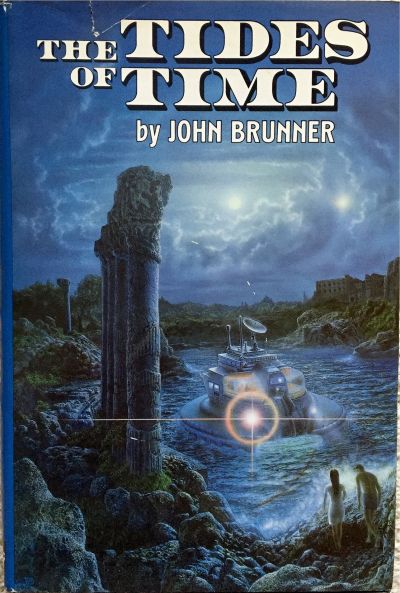A Better Place to Be
The Tides of Time
By John Brunner

25 Jun, 2024
John Brunner’s 1984 The Tides of Time is a stand-alone science fiction novel.
Travelers Gene and Stacy make port and set up camp in a cave on a backwater Greek island. They will be there for some time… centuries, by some measurements.
Gene and Stacy are outcasts: Gene is too black for the locals and they see pregnant Stacy’s relationship with Gene as an affront. Through means not immediately clear, Gene and Stacy live out lives in many eras. When not dodging hostile visitors, they while away their time discussing people familiar to them, but not to the reader.
Oragalia is a small island, without much beyond location to recommend it to the world. Its location ensures that the island has played host to a cross-section of imperial powers. The couple (under a variety of names) witness this dismal march of history in reverse order.
Featured are:
- Invasion (or at least visitation) by rich but annoying hippy tourists.
- Invasion by the Nazis.
- Visitation by obnoxious rich British people, guided by a representative of the fading Ottoman Empire.
- A visitor whose home era is unclear and whose vocabulary includes words like sterile and amniocentesis, noises the couple cannot understand.
- Invasion by particularly obnoxious Crusaders, whose holy mission boils down to looting any community unlucky enough to host them.
- A brief visit from unlucky merchants.
- A narrow escape from Romans eager to find slaves.
- An interlude possibly set during the Greek Bronze Age.
In the end, however, it is the future that comes calling for the pair, with dire consequences for one of them.
~oOo~
This review will be mostly negative so let me begin with praise: I did like the Don Dixon cover art (which for some reason I thought was a Sternbach). In retrospect I should have appreciated the golden age of SF book covers more than I did at the time.
Readers will very quickly realize that something odd is going on with the couple. However, Brunner is not keen to explain what that is. He prefers (rather uncommonly for an SF writer) to entice the reader by presenting a peculiar sequence of events without the context that would explain it. The general effect is very New Wave, which is unexpected in a book published a generation after the New Wave peaked.
There is an in-story explanation as to what is going on. It’s a disappointing explanation. Pretty much any alternative readers invent for themselves is likely to be more satisfactory.
The book as a whole read almost as though Brunner had made notes for a historical novel or perhaps a series about a Greek island, but later decided to cobble them together into an episodic science fiction novel. Although sections of the work are diverting, the novel as a whole is a disappointment.
Readers may sense a running theme of disappointment in my reviews of post-1975 Brunner books. Manshape, Players at the Game of People, and The Infinitive of Go all failed to spark joy. 1983’s The Crucible of Time is the main exception. Readers have only themselves to blame! Brunner’s best books demanded a level of effort not rewarded by improved sales1. If a dejected Brunner decided to focus his creative efforts somewhere other than SF, who could blame him?
Except, as we will see next month, the project that ate up so much of Brunner’s attention after 1975 was not exactly a resounding success.
The Tides of Time is available here (Amazon US), here (Amazon Canada), here (Amazon UK), here (Barnes & Noble), and here (Kobo). I did not find The Tides of Time at Apple, Chapters-Indigo, or at Words Worth Books.
1: We can see a similar pattern in the works of Robert Silverberg and Piers Anthony. They also discovered that commercial crap outsells more ambitious works. Granted, in the case of Anthony, his ambitious works were only ambitious by contrast with other Anthony books, not other SF authors. The moral: don’t expect the market to reward effort.
